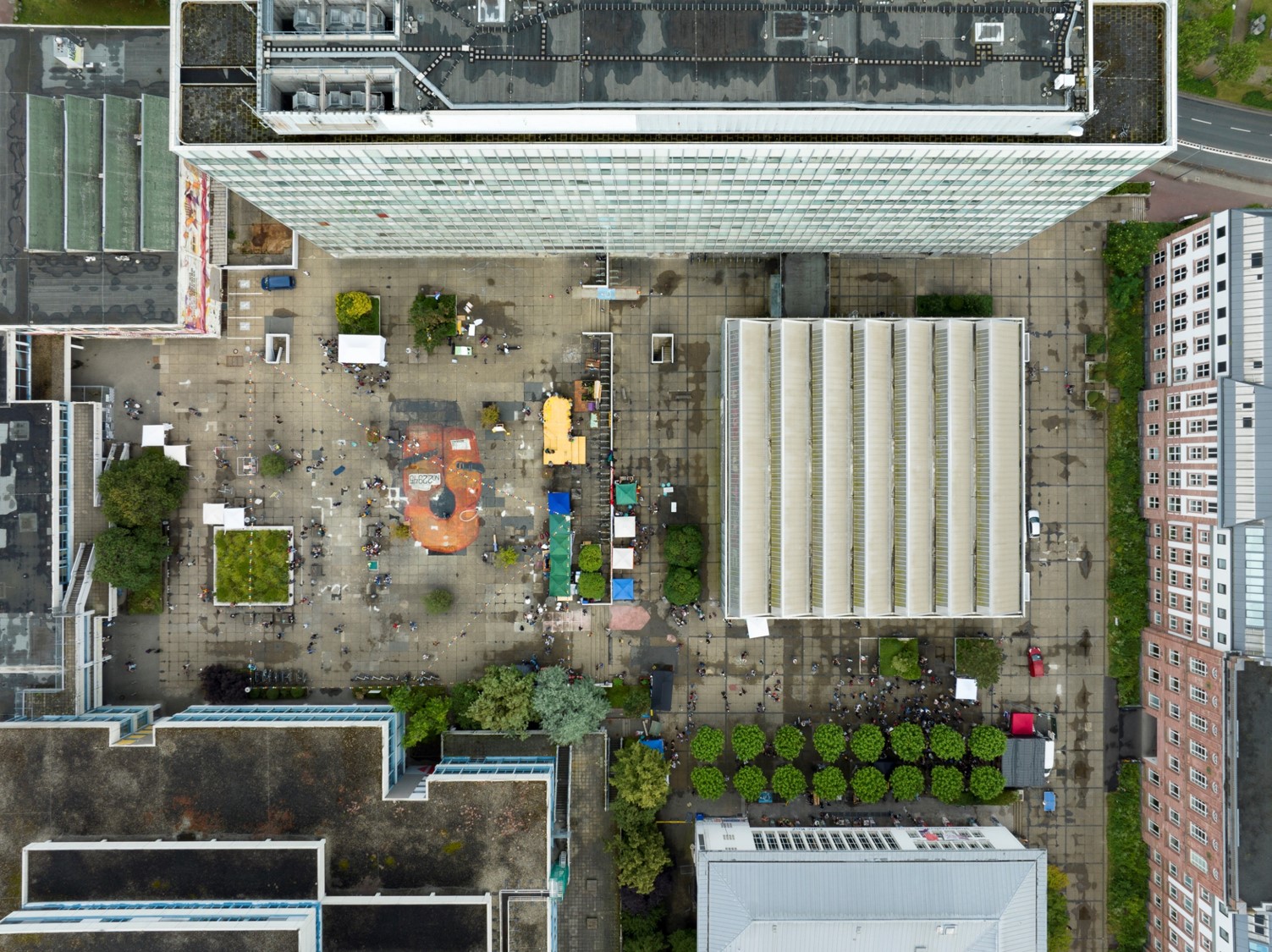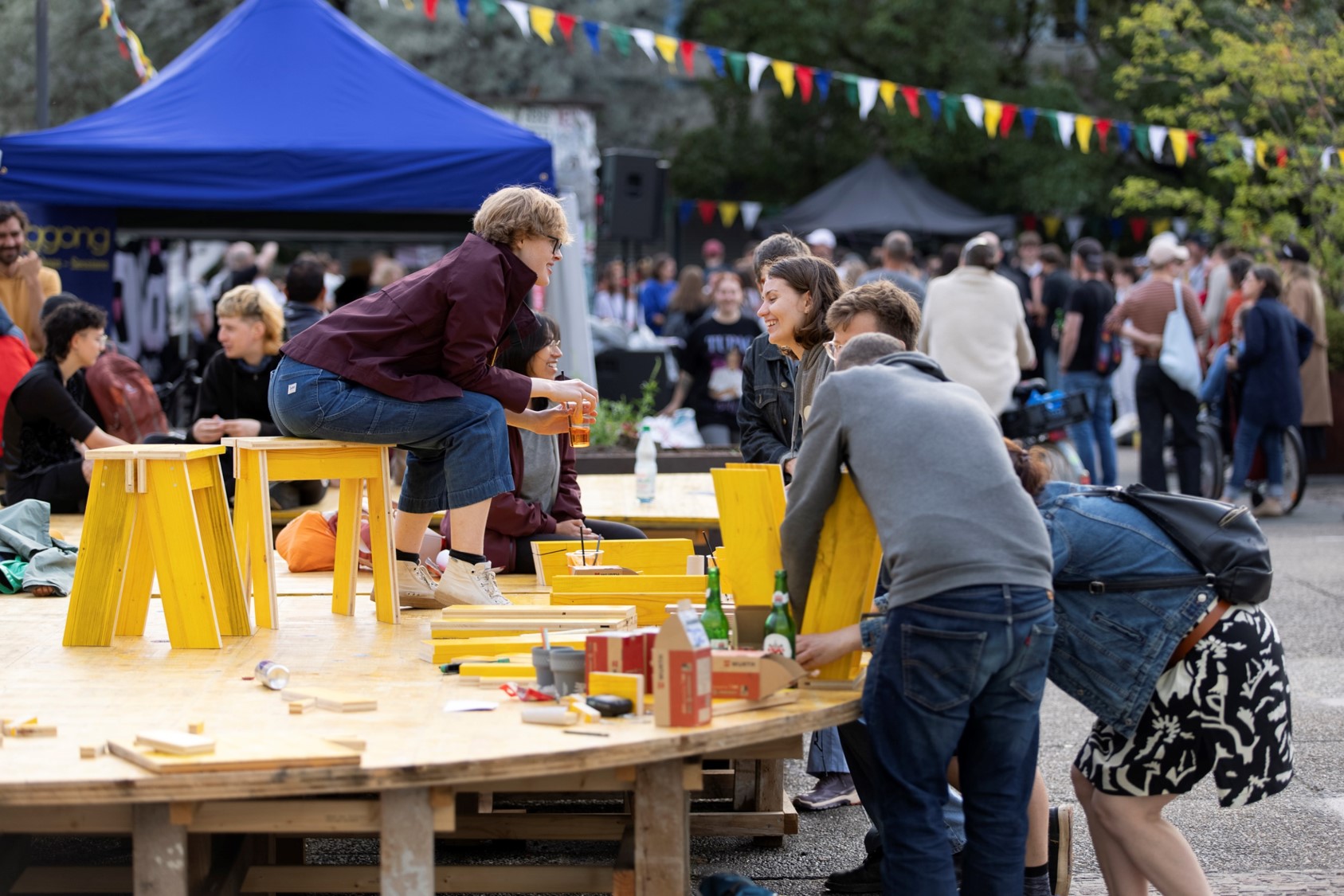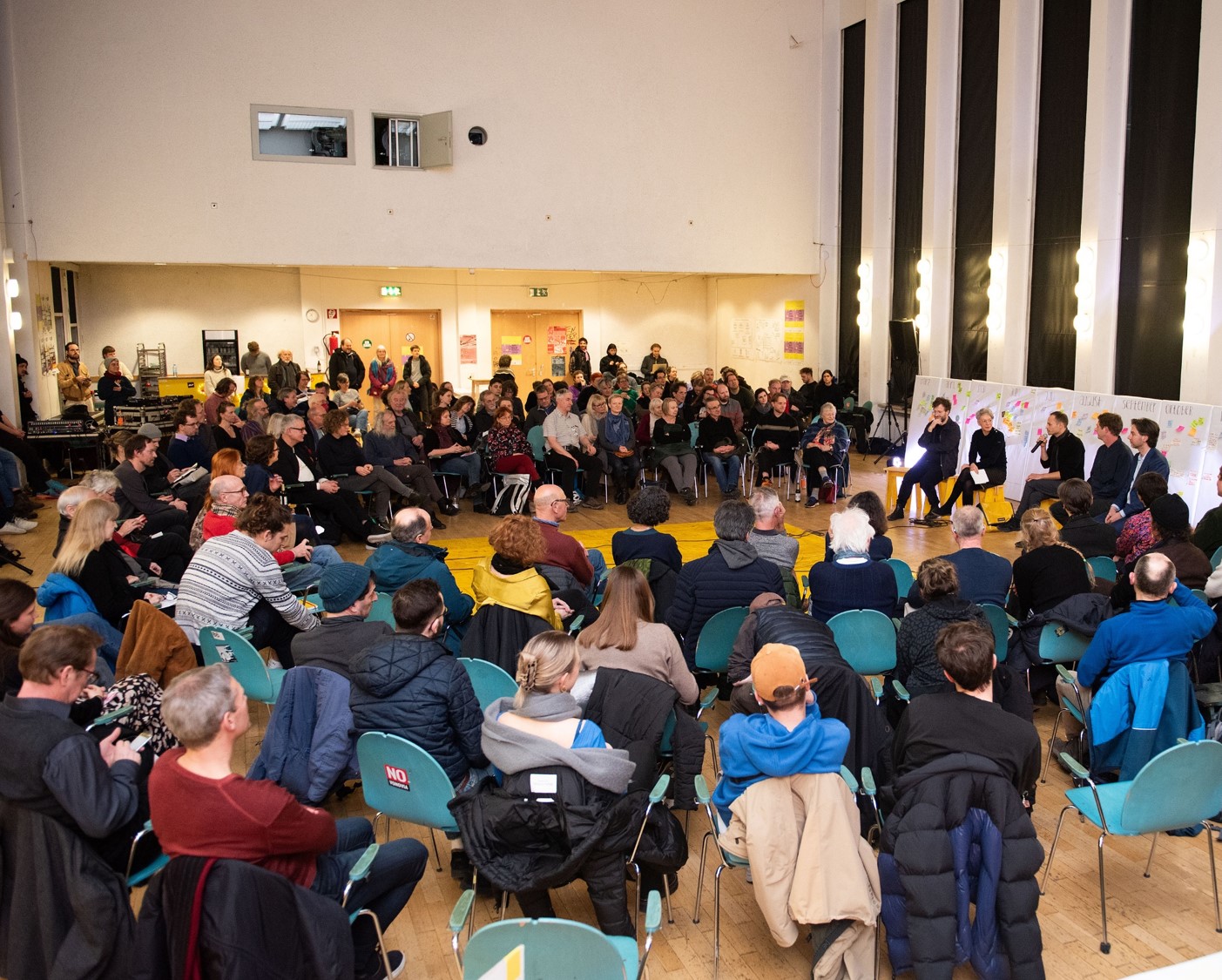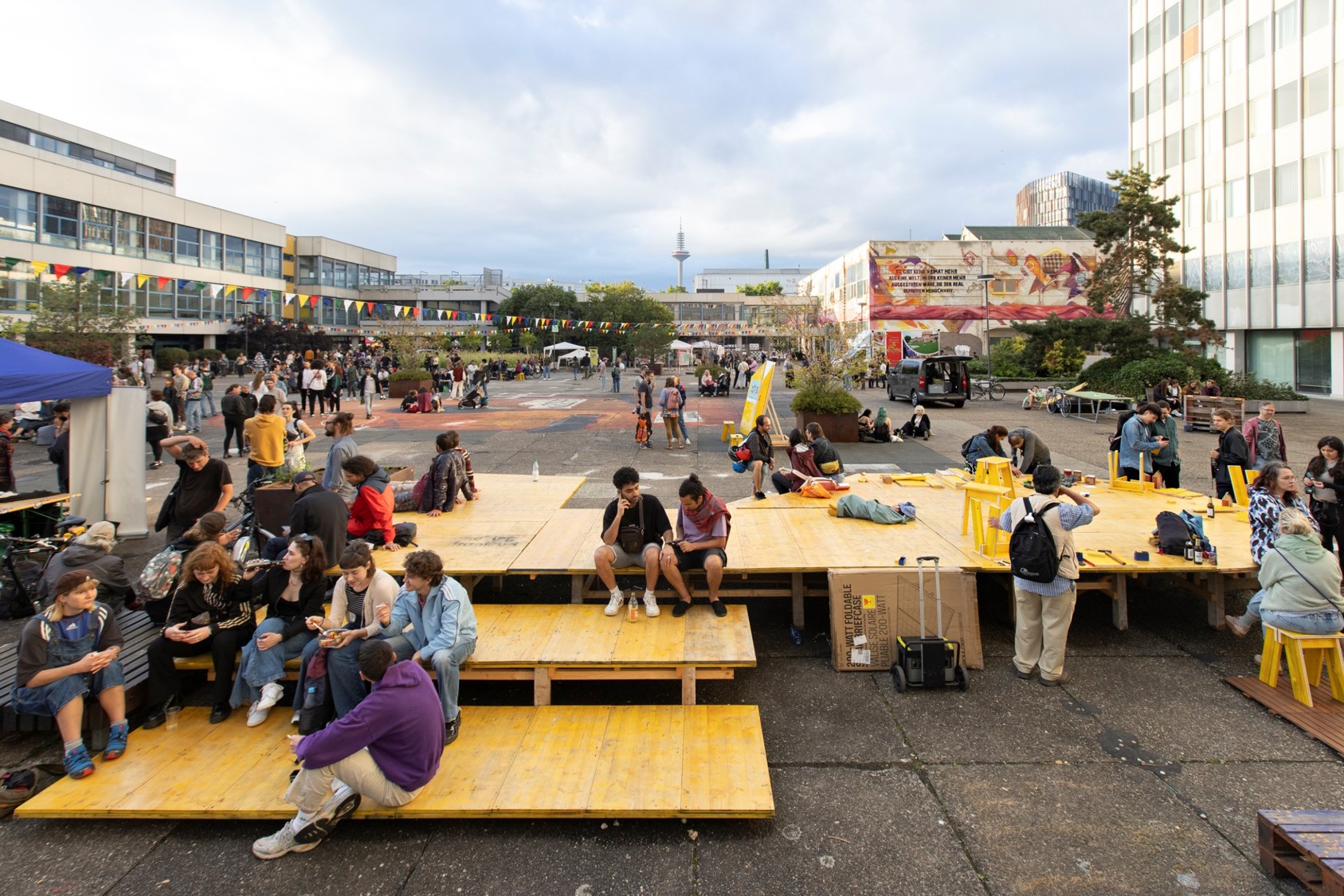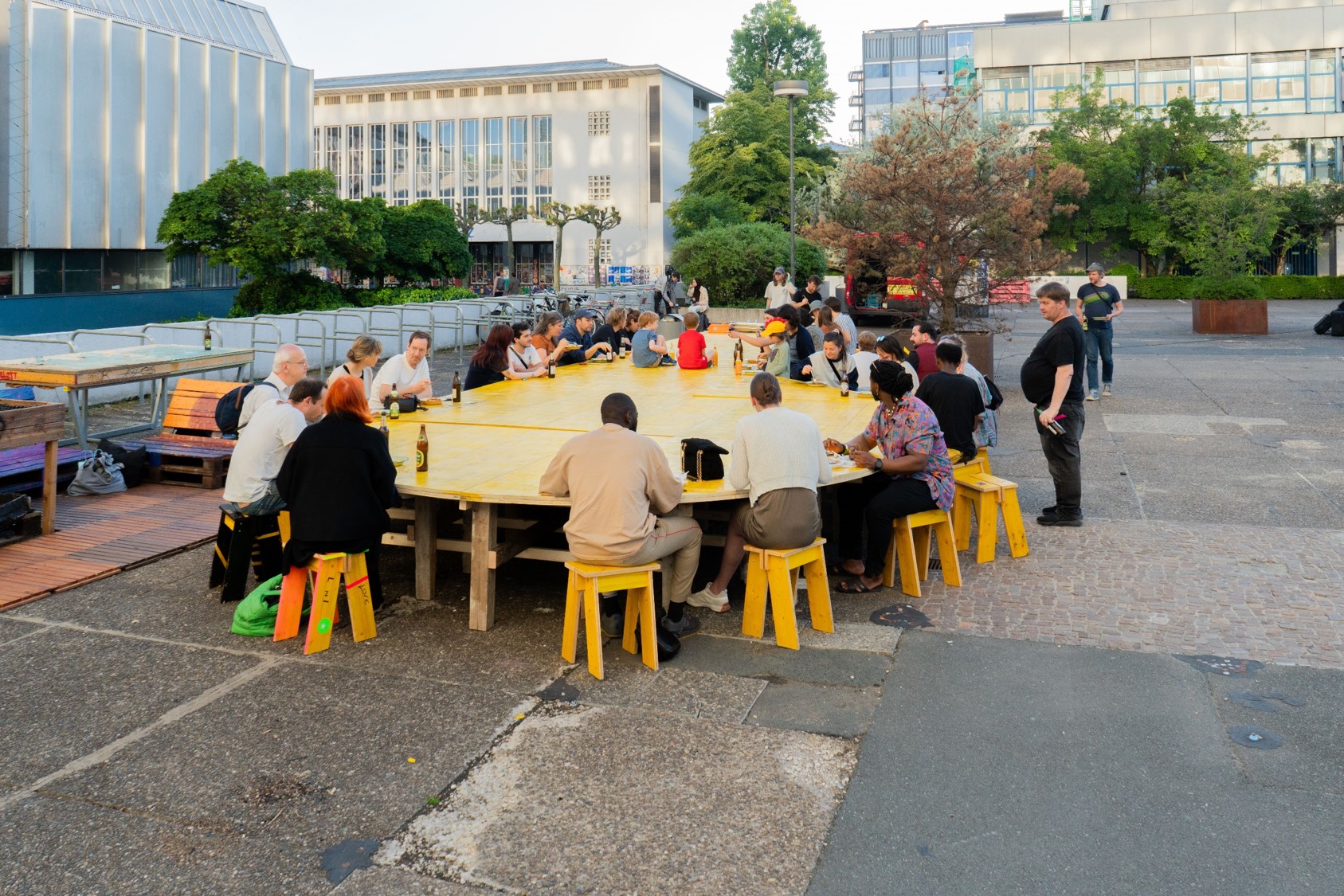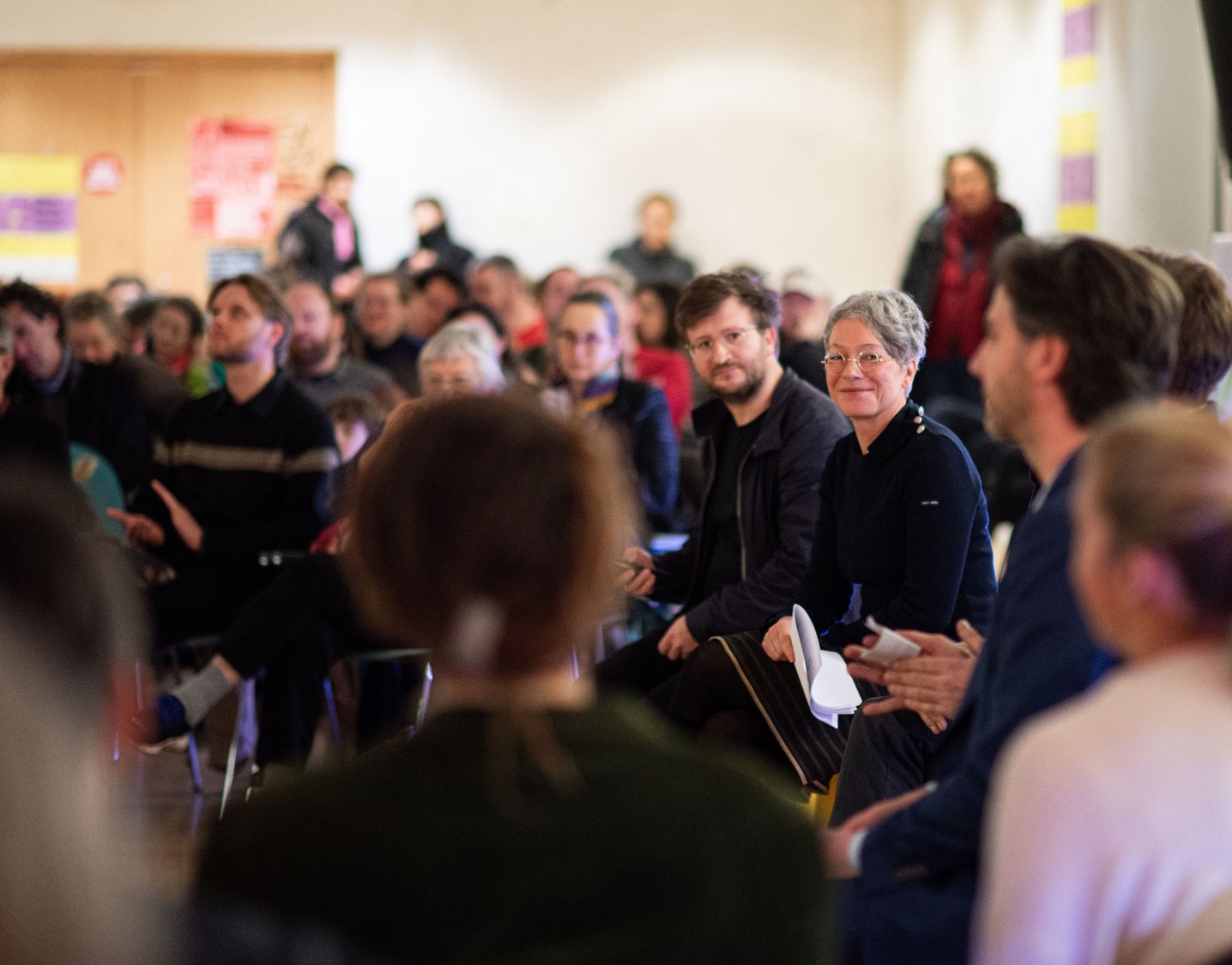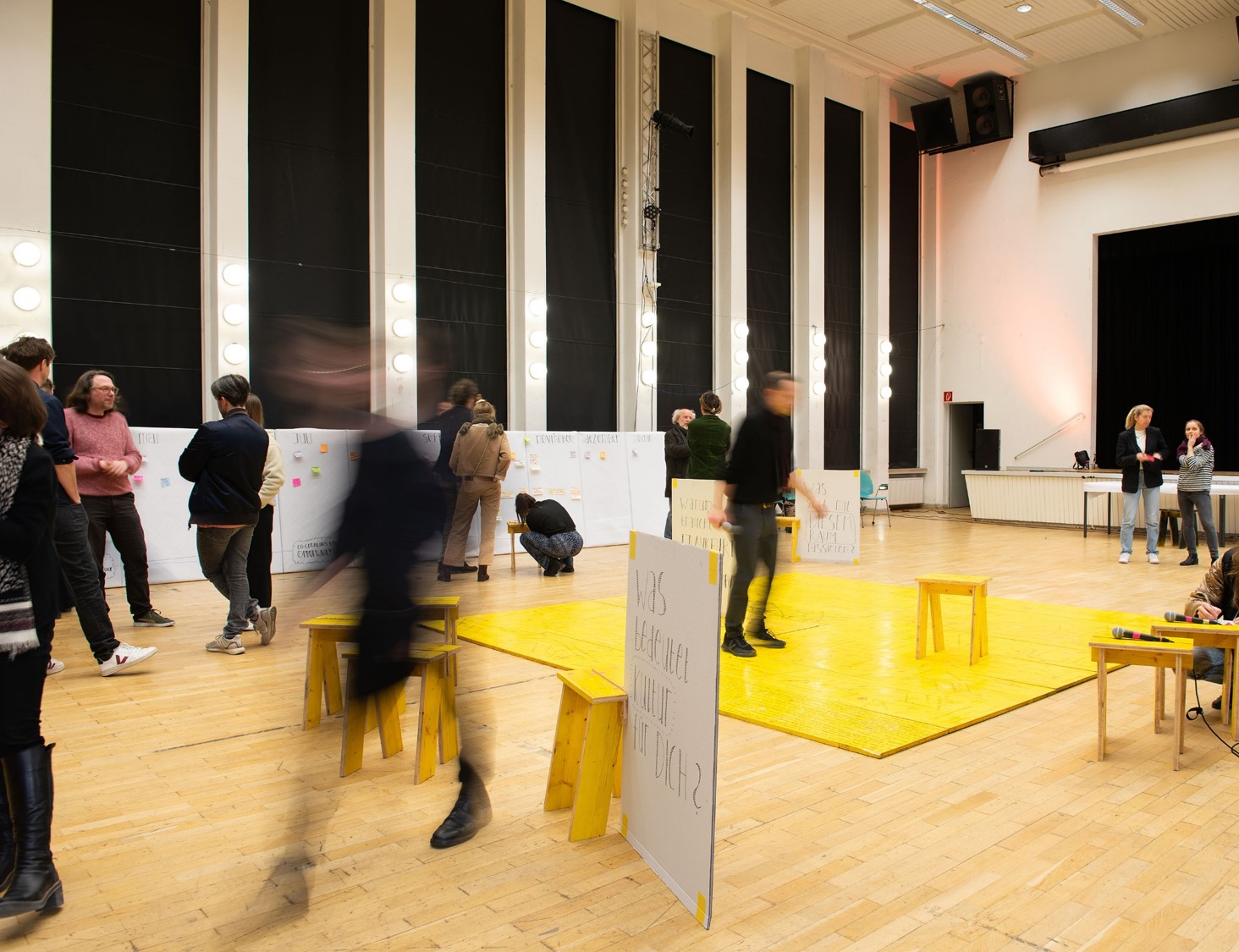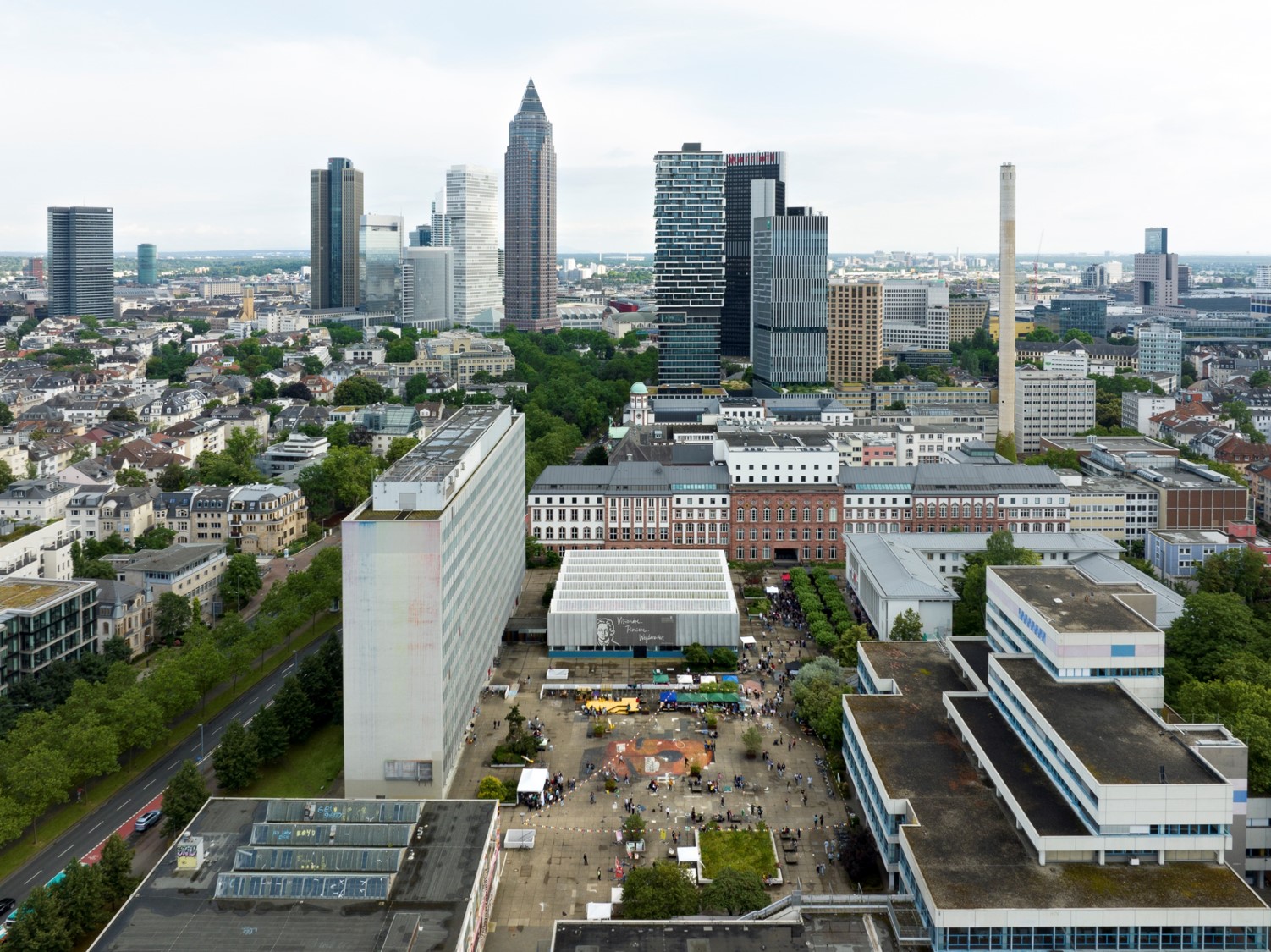Regaining a sense of belonging
Vision 31 - Co-Creating our Future Space
Vision 31 at Cultural Campus: Co-Creating our Future Spaces
The Vision 31 project at the Cultural Campus in Frankfurt am Main is building an experimental space. An open space that promotes dialogue, creativity, and culture for the responsible use of common resources for the city of tomorrow, in which everyone can be part of it. A space for active participation in urban development, in an urban area that is currently in the midst of a multifaceted transformation process of vacancy, interim use, visions and demolition.
Germany
Regional
City Frankfurt am Main, Hessen
Mainly urban
It refers to other types of transformations (soft investment)
Yes
2024-12-31
Yes
EIT Urban Mobility / Co-create NEB 2024 / 9.32 Cross-KIC Co-create NEB 2024
No
No
As a representative of an organisation, in partnership with other organisations
The 'Vision 31 - Co-creating our Future Space' project is a transformative initiative that aims to redevelop the former Frankfurt University campus into a dynamic cultural hub through arts, sustainability and inclusive community engagement. The project establishes a living laboratory that enables residents, stakeholders and cultural organizations to co-create the future of the campus. With a focus on resource sharing, accessible culture and non-commercial urban development, Vision 31 has fostered co-creation and dialogue that has redefined the use of since 15 years underutilized spaces. The collaboration between grassroots initiatives, local authorities, universities and citizens set a new standard for collaborative urbanism. The project promoted the inclusive and sustainable development of a shared cultural space in the city center of Frankfurt and laid the foundations for the integration of co-created ideas into long-term urban planning. Vision 31 adapted effectively to unexpected challenges and focused its activities on shared outdoor spaces on the former university campus.
Key activities:
_Temporary installations such as a multi-functional stage/round-table and open graffiti walls, making creative expression accessible.
_Themed events such as "Mix & Match" workshops, student-led urban design exercises and public symposia to ensure multi-stakeholder engagement.
_Co-design sessions with grassroots organisations, city authorities and academics to shape long-term urban planning strategies.
Key milestones included the development of 'recipes' for the interim cultural campus and a concept for the interim use of the Art Library with resource sharing at its core, strengthened partnerships with institutional stakeholders, a major closing symposium and the groundwork for the 'Cultural Campus Council'.
By transforming a transitional urban area into a meaningful and beautiful space, Vision 31 paves the way for a more sustainable and inclusive city of tomorrow.
Key activities:
_Temporary installations such as a multi-functional stage/round-table and open graffiti walls, making creative expression accessible.
_Themed events such as "Mix & Match" workshops, student-led urban design exercises and public symposia to ensure multi-stakeholder engagement.
_Co-design sessions with grassroots organisations, city authorities and academics to shape long-term urban planning strategies.
Key milestones included the development of 'recipes' for the interim cultural campus and a concept for the interim use of the Art Library with resource sharing at its core, strengthened partnerships with institutional stakeholders, a major closing symposium and the groundwork for the 'Cultural Campus Council'.
By transforming a transitional urban area into a meaningful and beautiful space, Vision 31 paves the way for a more sustainable and inclusive city of tomorrow.
Sense of Belonging
Sharing Resources
Co-Creation
Urban Commons
Multi-Stakeholder Process
The various discussions and workshops that took place within the Vision 31 project led to the development of a concept for the use of the Art Library, with resource sharing at its core. The activities of Vision 31 have focused on sustainability, inclusivity and participatory urban design, with an emphasis on resource efficiency and temporary use of spaces. The initiative has transformed vacant areas of the campus into vibrant spaces for cultural exchange and ecological transformation, fostering a sense of community ownership. Initial public workshops and open events laid a broad foundation for stakeholder participation, gathering diverse ideas and identifying thematic priorities such as art, resource sharing, culture for all, leisure without consumption, vibrant democracy and sustainability.
Aesthetics and design were an important part of all Vision 31 events and activities on the Bockenheim campus. This can be seen, for example, in the projects that focus on outdoor event areas and meeting places. Here, aesthetically and creatively exciting objects - such as a temporary stage that is also a round table or a bench - have contributed to a positive perception of the outdoor space and aesthetically enhanced the open space on the campus. Design interventions - small and large - support events that aim to change the perception of the space and try to involve different stakeholders in the urban design process. Targeting specific interest groups is also important. This has been achieved, for example, through mobile graffiti walls that can be sprayed, or raised beds that can be planted together. Design has also played an important role in the student designs from the Urban Planning and Architecture programmes, which have explored the campus and its future design as part of the project.
For the Vision 31 project team, it was particularly important not only to be open to all interest groups, but also to address them specifically according to their needs. Young people who use the campus in the evenings and at weekends for informal meetings and parties have different needs and require a different approach (to different topics and at different times), as do young families who want to teach their children how to cycle in the car-free area of the campus at weekends. For Vision 31, inclusiveness means offering different formats - tailored to different needs. And so the events took place at different times, in different rooms and with different themes, in order to get as many different voices as possible involved in the joint, co-creative planning of the campus. The diverse composition of the project team was particularly important for inclusion in the Vision 31 project. It consisted of the association Offenes Haus der Kulturen e.V., the civil society organisation Making Frankfurt, the Department of Culture and Science and the University of Applied Sciences.
Wondering who that is?
The Open House of Cultures (oHa) is an association that has been active at the Kulturcampus for many years and knows many of the actors and stakeholders involved very well. The oHa was responsible for project coordination and networking with local actors.
Making Frankfurt is a group of people in Frankfurt from various creative disciplines who have been working since 2020 to make the city a better place to live. It was primarily responsible for moderating and designing the temporary furniture on the campus.
The Department of Culture and Science was an important connector with the city and various authorities.
The Frankfurt University of Applied Sciences was active on campus with various student projects from the Social Work, Architecture and Urban Planning degree programs with different teaching formats from hands-on project to collaborative research seminars.
Wondering who that is?
The Open House of Cultures (oHa) is an association that has been active at the Kulturcampus for many years and knows many of the actors and stakeholders involved very well. The oHa was responsible for project coordination and networking with local actors.
Making Frankfurt is a group of people in Frankfurt from various creative disciplines who have been working since 2020 to make the city a better place to live. It was primarily responsible for moderating and designing the temporary furniture on the campus.
The Department of Culture and Science was an important connector with the city and various authorities.
The Frankfurt University of Applied Sciences was active on campus with various student projects from the Social Work, Architecture and Urban Planning degree programs with different teaching formats from hands-on project to collaborative research seminars.
The Vision 31 project has involved the municipality and various stakeholders in a number of ways. Firstly, the cooperation across levels is reflected in the Vision 31 project team. Here, the City of Frankfurt, a university, a civil society organisation and an association work hand in hand and meet regularly over a period of months. Together they organise symposia, moderate events and discuss the past and future of the campus with local residents and long-standing stakeholders. Through this close cooperation, the city can learn a lot about the processes of civil society organisations, students are directly involved in a current urban development process, and a wide range of local stakeholders are involved in a process in which they shape the future of the city together with the city, associations and initiatives on an equal footing.
The involvement of different stakeholders in the process design of the project was one of the core objectives of Vision 31. Through the equal participation of the city administration, civil society organisation and university in the project steering team, and through the various exchanges with already established local groups, future users and residents, cooperation across resort boundaries was not only encouraged but actively practised. This equal cooperation was further facilitated by the fact that all project partners are members of the EIT-funded project 'Cultural Campus. Co-Creating our Future Spaces' project funded by the EIT, and that they all received funding and were responsible for reporting. The involvement of as many different stakeholders as possible - from the past, present and future of the Cultural Campus - was always at the centre of the project design, with themes of co-creation, urban commons and co-design in planning processes at the heart of the project.
The different representatives from administration, research and civil society naturally brought a broad portfolio of working methods and strategies to the project team. By working closely together in the individual events and in the preparation of these events, the team members were able to learn a lot about the mechanisms, approaches and goals of different stakeholders and to reflect on these together in later events and sub-projects. The exchange with researchers from the Frankfurt University of Applied Sciences in the field of urban planning, architecture, social work on topics such as urban commons or climate-sensitive urban re-development also played an important role, as they looked at the process from a innovative scientific perspective and were able to share experiences with the project team from other best practice examples that had already been researched.
Why is Vision 31 innovative? Because it focuses on a current urban development process that is hotly debated at various levels of urban society, where there are still unresolved issues and conflicts in many areas. The project opend up a space to co-create the development of the future cultural campus in an honest dialogue at eye level between the city, initiatives, activists and observers. In this way, initiatives that have been active in the area for many years could act in the process, while at the same time involving future users. Together with interested parties who have not yet dared to get involved in the controversial process, they will have the opportunity to put down their first roots on site, many years before the planned new buildings on the campus become their new home, and to help shape the future spirit of this place. At the same time, this dialogue is not without risk, as not all wishes and ideas can always be realised to the same extent and compromises have to be made in many areas. The funding of Vision 31 by the EU (EIT Food) was essential for the success of this innovative project, because project coordination and event management, which provide a stage for culture, participation and exchange, and create a place that allows interested groups to participate, also require resources, funds for personnel costs, aesthetically pleasing structural interventions and more.
The engagement methodology for the project evolved into a focused and iterative approach to effectively engage local audiences in the co-design process. Initial public workshops and open events laid a broad foundation for stakeholder participation, gathering diverse ideas and identifying thematic priorities such as art, resource sharing, culture for all, non-consumptive leisure, vibrant democracy and sustainability. As the project progressed, engagement strategies became more focused, tailoring activities to specific interest groups to ensure deeper and more meaningful participation. Key methods included the 'Mix & Match' series, which combined informal discussions with cultural programming, creating accessible platforms for networking, dialogue and collaboration. Each event focused on one of the six thematic priorities in order to gain deeper insights and engage citizens and stakeholders with common interests to actively contribute to the future of the campus. Thematic events, such as planting and building sessions, brought the co-design process into tangible, interactive formats that resonated with the community. Symbolic infrastructure, such as the multifunctional stage and raised beds, played an important role in engagement by providing visible, usable spaces that encouraged local ownership and creativity. These spaces became hubs for interaction and the generation of new ideas for the development of the area. Consistent feedback loops were an integral part of the methodology. Input gathered at each event informed subsequent activities, ensuring alignment with community needs. Communication activities, including social media campaigns, posters and local outreach, broadened awareness and participation among underrepresented groups. By focusing on inclusivity, accessibility and iterative refinement, the project successfully bridged different perspectives and enabled local audiences to dynamically collaboratively and sustainably shape the plans for the art libary.
Many aspects of the Vision 31 project are transferable to other projects. On the one hand, the structure of the project set-up with 1. workshops; 2. the resulting definition of key issues and 3. their processing in different event formats, which are specifically aimed at different interest groups and stakeholders, as well as 4. the formulation of 'recipes' and 'demands' for the further, joint design of the space, is exemplary. On the other hand, the cooperation between the city administration, civil society and the university in a project team that works closely together and makes joint decisions is definitely a process structure that should be applied to other projects.
The project is exemplary for many other urban spaces undergoing fundamental change, and shows what a public, co-creative design of these places can look like, where the participation of different interest groups and stakeholders goes far beyond the mere exchange of opinions, creating a high level of acceptance for the process and allowing for greater inclusiveness in the sense that different needs groups are addressed in different formats.
Vision31 had a significant impact on its target groups by fostering inclusivity, dialogue and co-creation, and succeeded in raising awareness of the great potential and, in particular, the high quality of the open spaces on the campus as public spaces. Local residents and community stakeholders actively shaped the campus space by organizing flea markets and concerts, and participating in building sessions and workshops, increasing their sense of ownership. The project successfully engaged new administrative partners, such as the city planning office, strengthened institutional cooperation and laid the groundwork for integrating co-created ideas into long-term urban planning. V31 established cultural and academic actors who will use the space in the future actively participated in discussion rounds, contributing valuable insights and aligning their visions with community-driven outcomes. For the neighborhood and its citizens, the project transformed a previously underused area into a vibrant, accessible space with free and inclusive activities, enhancing its usability and beauty. This improved the quality of life for the community, and demonstrated the potential of cultural spaces to enrich democracy in urban life.
V31 focused on the sustainable use of materials in the construction workshops and the development of recycling systems in the food supply. V31 ran a sustainability workshop with an external institution and started a close exchange with the Natural History Museum. Towards the end of the project, we gained another institutional partner (the planning department of the city of Frankfurt am Main), which will strengthen our activities in the future. Vision 31 clearly had the support of established and grassroots associations and cultural organizations. V31 was able to achieve a high level of participation from different local target groups. As the events are inclusive and open to all, we have promoted inclusion.
V31 focused on the sustainable use of materials in the construction workshops and the development of recycling systems in the food supply. V31 ran a sustainability workshop with an external institution and started a close exchange with the Natural History Museum. Towards the end of the project, we gained another institutional partner (the planning department of the city of Frankfurt am Main), which will strengthen our activities in the future. Vision 31 clearly had the support of established and grassroots associations and cultural organizations. V31 was able to achieve a high level of participation from different local target groups. As the events are inclusive and open to all, we have promoted inclusion.

